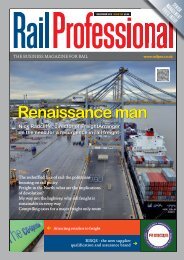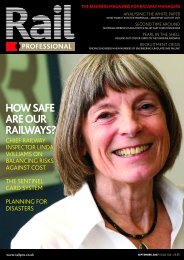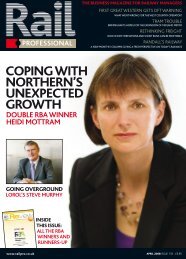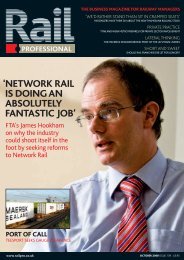View as PDF - Rail Professional
View as PDF - Rail Professional
View as PDF - Rail Professional
You also want an ePaper? Increase the reach of your titles
YUMPU automatically turns print PDFs into web optimized ePapers that Google loves.
Comment<br />
if this is <strong>as</strong> good <strong>as</strong> the sums are going to get, I can only conclude it<br />
remains vital and necessary.<br />
There are, nevertheless, very substantial problems with the<br />
Department for Transport’s c<strong>as</strong>e. The government h<strong>as</strong> built its<br />
c<strong>as</strong>e around the cornerstone idea that high speed rail would<br />
reduce the imbalance in the UK’s economy between north and<br />
south by improving transport links to the north. But is it really<br />
credible that Manchester would be transformed by having trains<br />
to and from London taking 80 minutes, rather than two hours,<br />
and four trains an hour rather than three Nor, <strong>as</strong> Rod Eddington<br />
pointed out in his report on the UK’s transport networks in 2006,<br />
is there anything to stop better transport links allowing people to<br />
live in a provincial city but to do their business somewhere else. It<br />
is distinctly possible that, <strong>as</strong> some suggest high speed rail in France<br />
h<strong>as</strong> done, new links would benefit professional services, retail and<br />
other sectors in the capital, at the expense of the provinces.<br />
HS2 is also being given perverse priority over other schemes<br />
that would, at le<strong>as</strong>t according to recognised cost-benefit analysis<br />
methods, do considerably more good. The arguments for a third<br />
runway at Heathrow – that the existing infr<strong>as</strong>tructure is so<br />
overstretched that the only option is to build something new – are<br />
precisely the same <strong>as</strong> those for building HS2 over tinkering with<br />
the existing West Co<strong>as</strong>t Main Line. The private sector would fund<br />
the runway and one serious study put the benefit-cost ratio for<br />
the project at 3.6:1 – against 1.4: 1 under the latest calculations for<br />
HS2.<br />
But events in the early hours of 3 February – when a<br />
Freightliner Cl<strong>as</strong>s 90 derailed at Bletchley, blocking all four tracks<br />
of the West Co<strong>as</strong>t Main Line – have made further nonsense of the<br />
already fairly far-fetched claims of those that claim high speed rail<br />
isn’t needed to solve London to Birmingham capacity problems.<br />
The single derailment illustrated precisely how fragile the existing<br />
line is. No-one who h<strong>as</strong> ever spoken to a senior Network <strong>Rail</strong><br />
manager about the challenges of handling a 200kph express train<br />
every three minutes on the f<strong>as</strong>t lines, while juggling the needs<br />
of freight and commuter services on the slow lines, would ever<br />
seriously entertain the anti-HS2 campaigners’ claims about the<br />
potential to enhance the line’s capacity. Moving block signalling,<br />
longer trains and some route straightening are all desirable – but<br />
far from sufficient to solve the looming capacity problem.<br />
This leaves the question of whether it could be done another<br />
way. Roger Ford, the Modern <strong>Rail</strong>ways columnist, h<strong>as</strong> argued<br />
for the building – at far lower cost – of a new, 200kph line to<br />
parallel the West Co<strong>as</strong>t Main Line. Instinct suggests this is an<br />
inconvenient half-way house, offering few of the journey time<br />
improvements of a high speed line while requiring much of the<br />
necessary investment. There are also voices calling for the new<br />
line’s maximum speed to be 300kph, <strong>as</strong> on High Speed One, rather<br />
than the 400kph proposed for HS2. But it is hard to imagine that<br />
the savings – which would mainly come from allowing tighter<br />
curves than are possible on a 400kph line – can be seriously<br />
justified when there are already 380kph top-speed trains on order<br />
in China.<br />
Yet the truth remains that the cost-benefit calculations have<br />
been undertaken mainly for a negative re<strong>as</strong>on – so that they can<br />
be produced at the almost inevitable judicial review hearing into<br />
the government’s decision. The serious arguments in favour of<br />
the project have, in fact, got far more to do with the theories<br />
championed by economists such <strong>as</strong> Oxford University’s Dieter<br />
Helm, who analyses the nature of the networks the UK needs in<br />
future, rather than the precise costs and benefits of individual<br />
links.<br />
Such arguments, not yet a recognised part of UK transport<br />
planning, hold that cost-benefit analysis fails to capture properly<br />
the benefits of radical changes to a country’s transport networks.<br />
It is, of course, possible for new transport links to prove less<br />
popular than expected and for costs to spiral out of control. The<br />
new line’s effects on the UK’s economic geography will probably<br />
be very different from everyone’s expectations.<br />
But, since the l<strong>as</strong>t few years’ frantic debate h<strong>as</strong> produced no<br />
better solution to the looming capacity problems than HS2, now<br />
is surely the time to stop arguing about whether to go ahead. The<br />
t<strong>as</strong>k now is to make the best possible job of building it.<br />
Robert Wright is the shipping and logistics correspondent for the<br />
Financial Times: robert.wright@ft.com<br />
Clarification: In Robert Wright’s February column he wrote that, on the<br />
day of the 2012 fares announcement by the Association of Train Operating<br />
Companies, Michael Roberts, its chief executive, stuck to arguments about<br />
how fare rises would pay for new trains and better services. We are happy<br />
to point out that Atoc issued a press rele<strong>as</strong>e – and Michael Roberts made<br />
a number of national broadc<strong>as</strong>t media appearances – explaining the overall<br />
level of fare rises is determined largely by government policy and the<br />
industry is working together to continue cutting costs. To see what Atoc<br />
issued that day, visit www.atoc.org/2012fares<br />
Constructing<br />
Better<br />
Health<br />
Personal<br />
Track<br />
Safety<br />
One Appointment,<br />
Two Certificates<br />
Always anticipating the needs of clients, Healthcare<br />
Connections perform a combined CBH & PTS medical,<br />
ideal for where the rail & construction industries cross<br />
over.<br />
Removing the need for two separate medicals, this<br />
innovative offering will reduce downtime and save you<br />
money. Contact us today to find out more.<br />
www.healthcare-connections.com<br />
t: 08456 773002 e: sales@healthcare-connections.com<br />
i<br />
march 2012 Page 17
















